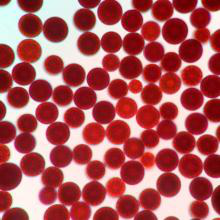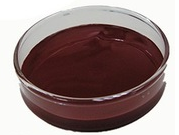2016 High quality Astaxanthin Factory for Bahamas
2016 High quality Astaxanthin Factory for Bahamas Detail:
[Latin Name] Haematococcus Pluvialis
[Plant Source] from China
[Specifications]1% 2% 3% 5%
[Appearance] Dark red Powder
[Particle size] 80 Mesh
[Loss on drying] ≤5.0%
[Heavy Metal] ≤10PPM
[Storage] Store in cool & dry area, keep away from the direct light and heat.
[Shelf life] 24 Months
[Package] Packed in paper-drums and two plastic-bags inside.
[Net weight] 25kgs/drum
Brief Introduction
Astaxanthin is a natural nutritional component, it can be found as a food supplement. The supplement is intended for human, animal, and aquaculture consumption.
Astaxanthin is a carotenoid. It belongs to a larger class of phytochemicals known as terpenes, which are built from five carbon precursors; isopentenyl diphosphate and dimethylallyl diphosphate . Astaxanthin is classified as a xanthophyll (originally derived from a word meaning “yellow leaves” since yellow plant leaf pigments were the first recognized of the xanthophyll family of carotenoids), but currently employed to describe carotenoid compounds that have oxygen-containing moities, hydroxyl or ketone , such as zeaxanthin and canthaxanthin. Indeed, astaxanthin is a metabolite of zeaxanthin and/or canthaxanthin, containing both hydroxyl and ketone functional groups. Like many carotenoids, astaxanthin is a colorful, lipid-soluble pigment. This colour is due to the extended chain of conjugated (alternating double and single) double bonds at the centre of the compound. This chain of conjugated double bonds is also responsible for the antioxidant function of astaxanthin (as well as other carotenoids) as it results in a region of decentralized electrons that can be donated to reduce a reactive oxidizing molecule.
Function:
1.Astaxanthin is a powerful antioxidant and may protect against oxidative damage to body tissues.
2.Astaxanthin can improve the immune response by increasing the number of antibody producing cells.
3.Astaxanthin is a potential candidate to treat neurodegenerative disease such as Alzhimer and Parkinson diease.
4.Astaxanthin dan reduce UVA-light damage to skin such as sunburn, inflammation, ageing and skin cancer.
Application
1.When applied in pharmaceutical field, astaxanthin powder has the good function of antineoplastic;
2.When applied in health food field, astaxanthin powder is used as food additives for pigment and health care;
3.When applied in cosmetic field, astaxanthin powder has the good function of antioxidant and anti-aging;
4.When applied in animal feeds field, astaxanthin powder is used as animal feed additive to impart coloration, including farm-raised salmon and egg yolks.
Product detail pictures:

Related Product Guide:
To be a result of ours specialty and service consciousness, our enterprise has won an excellent status between buyers all around the globe for 2016 High quality Astaxanthin Factory for Bahamas , The product will supply to all over the world, such as: Singapore, Cambodia, Switzerland, For more than ten years experience in this filed, our company has gained high reputation from home and abroad. So we welcome friends from all over the world to come and contact us, not only for business, but also for friendship.
Hi guysss, here is my natural makeup look tutorial! Re-filmed it 3 times until I thought it was acceptable hehe so please sit back and enjoy! ![]()
__________________________________________
PRODUCT DETAILS:
Make Up For Ever Step 1 Skin Equalizer Hydrating Primer | https://www.sephora.com/step-1-skin-equalizer-primer-P393965?skuId=1669159&icid2=products%20grid%3Ap393965
It Cosmetics Your Skin But Better CC Cream Spf 50+ | https://www.sephora.com/your-skin-but-better-cc-cream-spf-50-P411885?skuId=1868165&icid2=products%20grid:p411885
Maybelliner Fit Me! Concealer | https://www.amazon.com/Maybelline-New-York-Concealer-Light/dp/B0046VJTX8
Innisfree No Sebum Mineral Pact | https://www.amazon.com/Innisfree-No-Sebum-Mineral-Pact/dp/B005OU2NIS
Bobbi Brown Instant Pretty Eye and Cheek Palette | https://www.amazon.com/Bobbi-Brown-Instant-Pretty-Palette/dp/B00R9ZML4C
Wet and Wild Au Naturel palette in Nude Awakening | https://www.wetnwildbeauty.com/new/au-natural-palette-nude-awakening.html#sm.00000c8xycm11aadwcvkf7m4wfwu4
BCL BrowLash EX Slim Gel Pencil Liner | https://prettyandcute.com/BCL-Browlash-EX-Slim-Gel-Pencil-Liner-p6771.html
Estee Lauder Little Black Primer | https://www.esteelauder.com/product/631/34319/product-catalog/makeup/little-black-primer/tint-amplify-set
Majolica Majorca Lash Expander Liquid Extension BK999 | https://global.rakuten.com/en/store/miryoku/item/4901872025138
Kanebo Kate Eyebrow Pencil BR-3 | https://www.amazon.com/Kanebo-Kate-Eyebrow-Pencil-BR3/dp/B0084M4CLY
Etude House Color My Brows #1 Rich Brown | https://www.amazon.com/Etude-House-Color-Brows-Brown/dp/B005T8CCNQ
Wet and Wild MegaGlo Contouring Palette in Dulce de Leche | https://www.wetnwildbeauty.com/face/highlight-contour/mega-glo-contouring-palette.html#sm.00000c8xycm11aadwcvkf7m4wfwu4
Too Cool for School Art Class by Rodin Highlighter | https://www.amazon.com/Cool-School-Class-Rodin-Highlighter/dp/B019DQ0NUI
En Oleur Lip Liner in Tea Rose (there are better ones on the market)
Bite Beauty High Pigment Pencil in Meritage | https://www.sephora.com/high-pigment-matte-pencil-P283905?skuId=1449719
____________________________________________
MUSIC:
DJ Grumble – RareJewelz
_____________________________________________
Hope you enjoyed the look! Please like and subscribe ;D
America’s Pharmacist, Suzy Cohen RPh discusses the health benefits of herbal tea made from marshmallow root. This may help you with reflux, GERD, heartburn, canker sores, stomach problems, bladder pain, and UTIs.
As an international trading company, we have numerous partners, but about your company, I just want to say, you are really good, wide range, good quality, reasonable prices, warm and thoughtful service, advanced technology and equipment and workers have professional training, feedback and product update is timely, in short, this is a very pleasant cooperation, and we look forward to the next cooperation!







